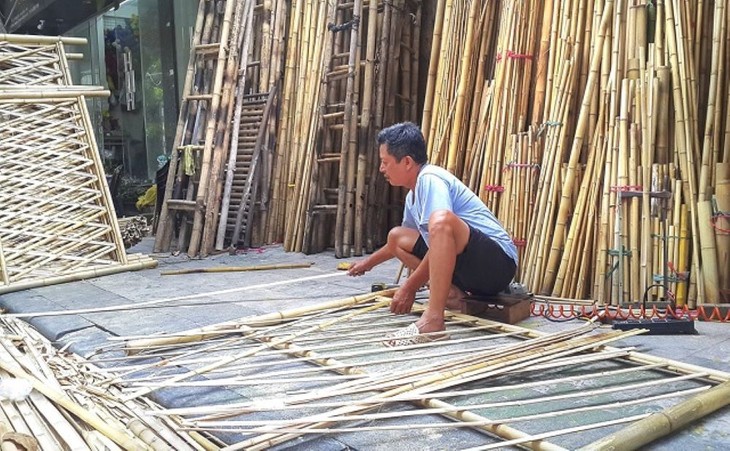(VOVWORLD) -Hanoi’s 36 ancient streets symbolize the history and culture of Vietnam’s thousand-year-old capital. Most of these streets are named after the main craft made or item sold on that street for many, many years. Hang Vai (Fabric Street) is an exception. Located 600m northwest of Hoan Kiem Lake, Hang Vai is actually selling bamboo in the heart of the Old Quarter.
 Hang Vai street is considered a special bamboo street in the heart of the Old Quarter. (Photo: hanoimoi.vn) Hang Vai street is considered a special bamboo street in the heart of the Old Quarter. (Photo: hanoimoi.vn) |
Along both sides of the 240-meter-long street, bundles of tall bamboo poles and bamboo ladders are neatly propped against every available surface, creating a unique "bamboo forest in the heart of Hanoi" that impresses first-time visitors.
Because bamboo and bamboo products are the main things sold on this street, many people confuse Hang Vai with Hang Tre (Bamboo Street), which is 2km away.
Hang Vai is a street that has preserved the ancient beauty of the capital city. In the second half of the 19th century, Hang Vai was near Dong Thanh market in Tho Xuong district, which is now Hang Bo ward in Hoan Kiem district.
It was then a busy center for trading all kinds of goods, but mainly fabrics. Hanoi people called the street Hang Vai because brown dyed fabrics were sold there to people who couldn’t afford expensive silk fabrics sold in Hang Dao street.
During the French colonial period, the French called Hang Vai “Rue Des Etoffes”. The advent of French customers resulted in a diversification of the types of goods sold there. As time went by, the guild model waned and since the 1990s, textiles lost their dominant position. Many merchants on the street switched to trading bamboo products. Now no trace remains of the textile trade except the street name.
 In the middle of the busy street, a craftsman still focuses on his work. (Photo: kinhtedothi.vn) In the middle of the busy street, a craftsman still focuses on his work. (Photo: kinhtedothi.vn) |
For decades, bamboo, rattan, and reed products have predominated. Craftsmen in Hang Vai process various types of bamboo for use in architecture, construction, and furniture. There are 10 shops selling bamboo products there now.
Nguyen Dac Hai, the owner of a shop in Hang Vai street, said, “My family specializes in making traditional bamboo products for building houses such as thatched roof houses, and folk games such as swings or stilts. Several people in my family – my father, my uncles, my aunts, and my uncles – are engaged in the craft. My shop was handed down through many generations.”
Another shop owner Nguyen Huyen Linh told VOV that her shop specializes in selling bamboo products, bamboo trees, artificial leaves for interior decoration, dried bamboo poles, and bamboo for wall cladding.
“Foreign tourists often come to Hang Vai Street to shop for handicrafts made of bamboo and reed. They also like to buy bamboo ladders for decoration, ladders to hang towels, and bamboo pipes. They’re surprised that bamboo pipes are used to smoke thuoc lao (Vietnamese tobacco). My family makes 30 to 50 products a day,” said Linh.
Nguyen Trong Duc’s family has been engaged in the craft for years. His shop in Hang Vai Street makes architectural and interior products from bamboo and reed.
He recalled, “I make bamboo partitions, cabinets, shelves, tables, and chairs. My day begins at 6:30 or 7:00 am. I usually make an appointment to come to the customer's house to install the ordered items, which are made here. Bamboo products are becoming more and more popular, but mainly among people in the suburbs. In the city, people mainly use bamboo for decoration. I also make items at the customer’s request.”
 The beauty of daily life on Hang Vai street (Photo: Hoang Chien) The beauty of daily life on Hang Vai street (Photo: Hoang Chien)
|
Customer Nguyen Quang Thao told VOV that he likes nostalgic art, so he sometimes stops by Hang Vai street to sit and watch and learn bits and pieces of tricks from the shop owner and admire this ancient street.
The rhythm of life on this street in the heart of Hanoi's Old Quarter has remained unchanged over the years. The only difference is that now it’s a younger generation maintaining and developing the street’s traditional craft.